
_________
For centuries, women across the world have been making textiles in their homes. Kantha quilts were born out of a scarcity of material, and are still made by repurposing old clothes like used sarees and dhotis. What do kanthas tell us about the lives of the makers and of the keepers? Painted Stitches, Woven Stories traces the journey of motifs and stitches from cloth to contemporary art.

Caption and Script
Caption: Kantha with the inscription ‘Tara Mata Radha Krishna’ which was made in Undivided Bengal in the 19th century.
Script: I had heard that almost everyone from Bengal and Bangladesh had lived with kantha personally in their homes, found them in their grandmother’s trunk or encountered them at museums. My friend Paromita recalls the kantha quilt that her mother made using her grandmother’s old saree, she says “it wasn’t colourful, it was a plain white saree with a blue floral border..”
But what is kantha when it can take on so many forms and what stories do its makers tell with colours, motifs, stitches and symbols?
The quilted and embroidered cloth here is a kantha which resembles the floor drawings or alpanas made during the lunar festivals. Look how the borders repeat like an optical illusion and merge at the lotus in the center. I discovered three Bengali inscriptions and found that they were embroidered in reverse….like a mirror image. So we had them translated and I asked questions..Was the kantha made or gifted to Shri Harichandra Chakrabarti or Shri Biplab Gopta? Was it a gift from one to another, or somebody’s child? Could these be the names of the father, son or husband of the maker? What we do not know is the name of the woman who made this kantha.
I saw Radha Krishna chants across the borders of vaishnav kanthas like the embroidered Bengali inscriptions that appear below the lotus of the kantha.

Kantha with the inscription ‘Tara Mata Radha Krishna’ which was made in Undivided Bengal in the 19th century.

Caption and Script
Caption: Kantha with kalkas (mango motifs) which was made in Undivided Bengal in the 19th century
Script: In the 19th century women sat together in their houses quilting and embroidering kanthas like the quilt here. Women still make kantha in their homes today. Kantha literally meant rags in Bengali because women used their worn out kora/unbleached saris or cloth found at home and gave it a new life. They do it quite intelligently like in this kantha, the maker has created a ripple effect or a chattayee pattern by running white stitches across it. The stitches of the kantha with this ripple effect guides us through the embroidered motifs. We see birds, butterflies or rain moths, trees and kalkas defying gravity.
Can you spot a little figure at the detail of the kantha? (Pause)
This figure could be the mischievous Hindu deity Krishna with his hair tied in a bun and a peacock feather sticking out.

Kantha with kalkas which was made in Undivided Bengal in the 19th century.
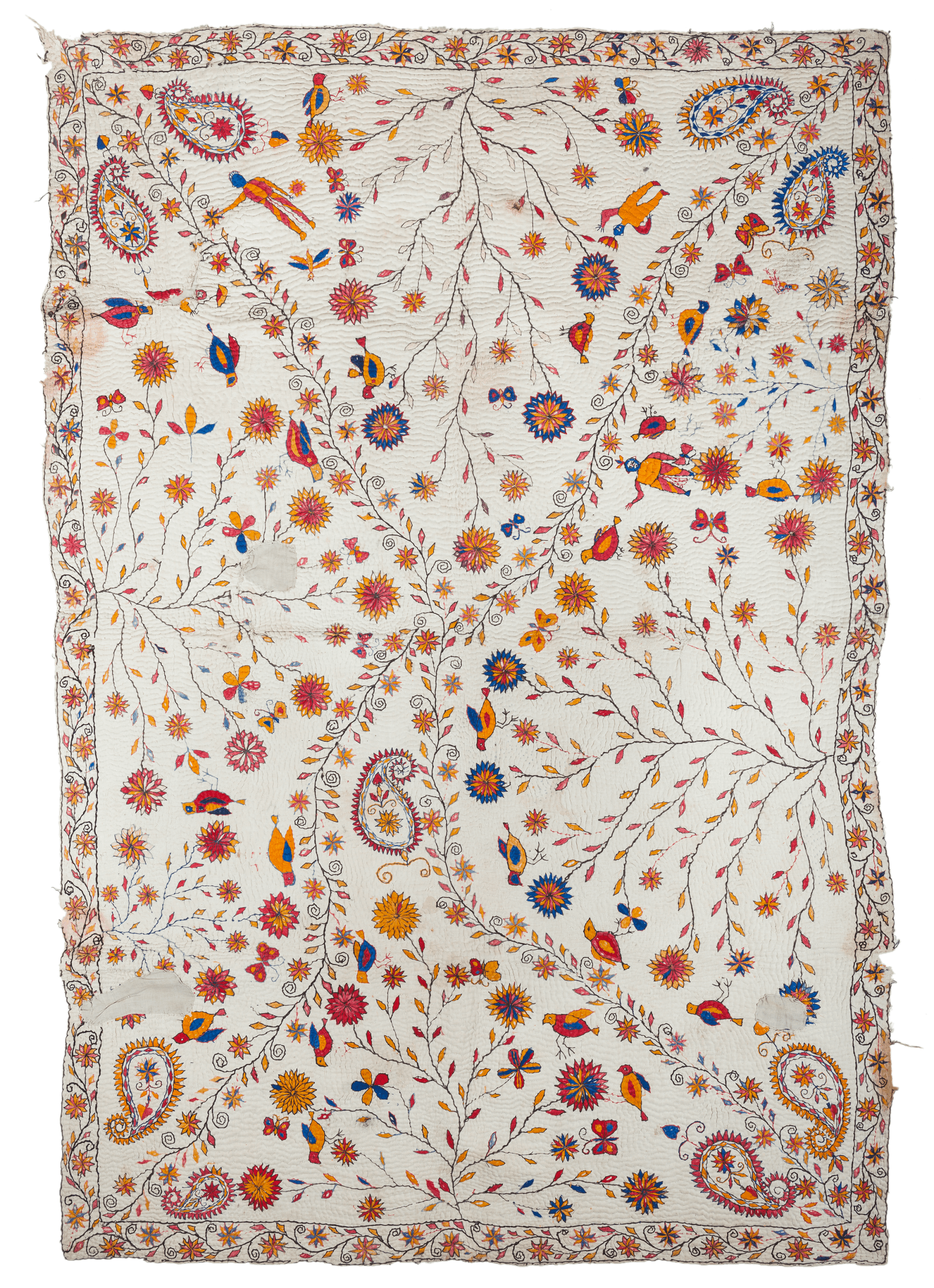
Caption and Script
Caption: Kantha with a leaf pattern which was made in Undivided Bengal in the 20th century.
Script: Motifs in this kantha tell many known and hidden stories of movement. In the center we see elephants in black that roam throughout the kantha in pairs. I read that textile scholar Perveen Ahmad calls them “clouds from a distance”.
Are the motifs surrounding the elephants depicting the movement of winnows used to blow through grains? Winnows are devices to separate the grain from its outer covering and are especially important for farming that was practiced by women and their families. Perhaps, you can imagine a child holding a paper fan in a windy space to imagine the same effect.
Did you notice that one odd yellow leaf? I wonder why only one leaf was coloured in yellow.

Kantha with a leaf pattern which was made in Undivided Bengal in the 20th century.
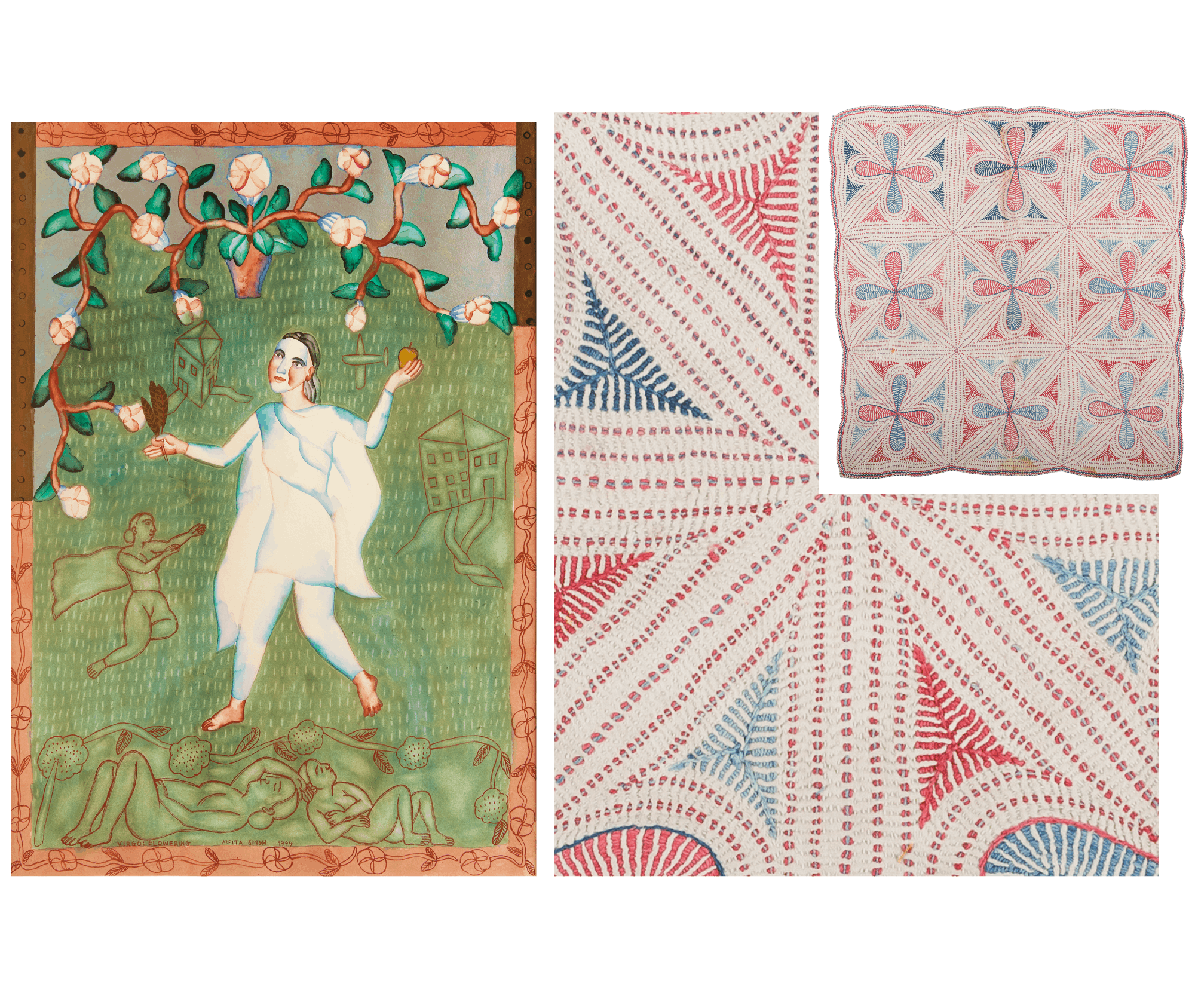
Caption and Script
Caption: A watercolour painting from Arpita Singh’s zodiac series titled ‘Virgo:Flowering’ made in 1999. Next to it is an abstract floral kantha which was made in Undivided Bengal in the early 20th century.
Script: An abstract floral kantha which was made in Undivided Bengal in the early 20th century. Kantha’s motifs and the practice of quilting had an impact on the lives and practices of artists like Meera Mukherjee and Arpita Singh. In this painting from Arpita Singh’s Zodiac series, I noticed that the white dashes, running through her paintings, resemble the kantha stitch. Almost invisible, the white on white stitches like the kantha next to it, appear as white on colour in her paintings.
Arpita Singh grew up in North Calcutta and the Bangali Mal Market area of Delhi. She even spent 4 years as a textile designer at the Government Weavers Center in Delhi where she often worked with kanthas. Coincidently, Singh revisited depictions of tactile textiles in her paintings in the 90s (this painting is from 1999).

A watercolour painting from Arpita Singh’s zodiac series titled ‘Virgo:Flowering’ made in 1999. Next to it is an abstract floral kantha which was made in Undivided Bengal in the early 20th century.

Caption and Script
Caption: A water colour painting from Arpita Singh’s zodiac series titled ‘Pisces: Compassion’ made in 1999. Next to it is a kantha with repetitive animal motifs which was made in undivided Bengal in the late 19th century.
Script: Kantha’s were used in many ways, to wrap a baby in them, as a table cloth or as a bedspread, which is why they can be read by rotating and viewing them from any angle. Whichever way you turn the kantha, every angle, stitch, form and shape tells you a new story.
In this rare kantha which is divided into asymmetrical sections, I discovered that by showing peacocks, snakes and fishes, the makers were indicating spiritual elements like life and death. Similarly, Arpita Singh’s painting from the Zodiac series depicts mirror images. The borders with floral motifs, the linear sections and a meditative figure remind me of kantha compositions.
In Poet Prayag Shukla’s poem on Arpita ‘yaha baiman kuch bhi nahi’ (here nothing will deceive you) there was a line that really struck me. He said that Arpita has her own universe, where both life and death are reflected in her paintings. Similarly, making kantha was a meditative feeling. Women collectively based their soul at the center. This was also common in alpanas that were made on floors.

A water colour painting from Arpita Singh’s zodiac series titled ‘Pisces: Compassion’ made in 1999. Next to it is a kantha with repetitive animal motifs which was made in undivided Bengal in the late 19th century.

Caption and Script
Caption: A kantha probably made by the maker ‘kalachand’ depicting scenes of daily life made in the 1980s under the guidance of Meera Mukherjee.
Script: In the 1980s the artist Meera Mukherjee developed many projects with new interpretations of kantha. While attempting to understand who made these kanthas, In our museum collection, I encountered a few accounts of it.
Here is a kantha with an embroidered signature in Bengali which translates to kalachand on it. You can find the signature floating above the man in a vehicle or cart. I wonder who kalachand is? Is he one of the makers of this textile or could he be someone the maker knew?
Let me give you some context about how these kanthas came into being. Meera Mukherjee liked to gather together the children around her home and she often noticed them drawing with chalk on their slates. Of
She felt that kantha’s motifs were very similar to the creativity and imagination of children so she guided them to make compositions while she trained artisans to stitch them. They would draw, paint and embroider everyday events from inside and outside their homes like the kantha here.

A kantha probably made by the maker ‘kalachand’ depicting scenes of daily lives made in the 1980s under the guidance of Meera Mukherjee.

Caption and Script
Caption: A kantha made by artisans depicting scenes of daily lives in the 1980s under the guidance of Meera Mukherjee.
Script: Continuing my exploration of Meera Mukherjee’s of kanthas, in this kantha, the artisans depicted different incidents on the same cloth. Can you relate to a child climbing down a tree with coconuts or fruits while another child looks out for him to your childhood experiences?
Can you spot two children playing football and a cat-like animal jumping onto a tree? Three people with yellow and orange hair move above the trees and an upside down bird defies gravity. These motifs in colours like red, green and yellow are possible because the artists decided that the background colour would be blue which is different from the unbleached white cotton of conventional kanthas.

A kantha made by artisans depicting scenes of daily lives in the 1980s under the guidance of Meera Mukherjee.
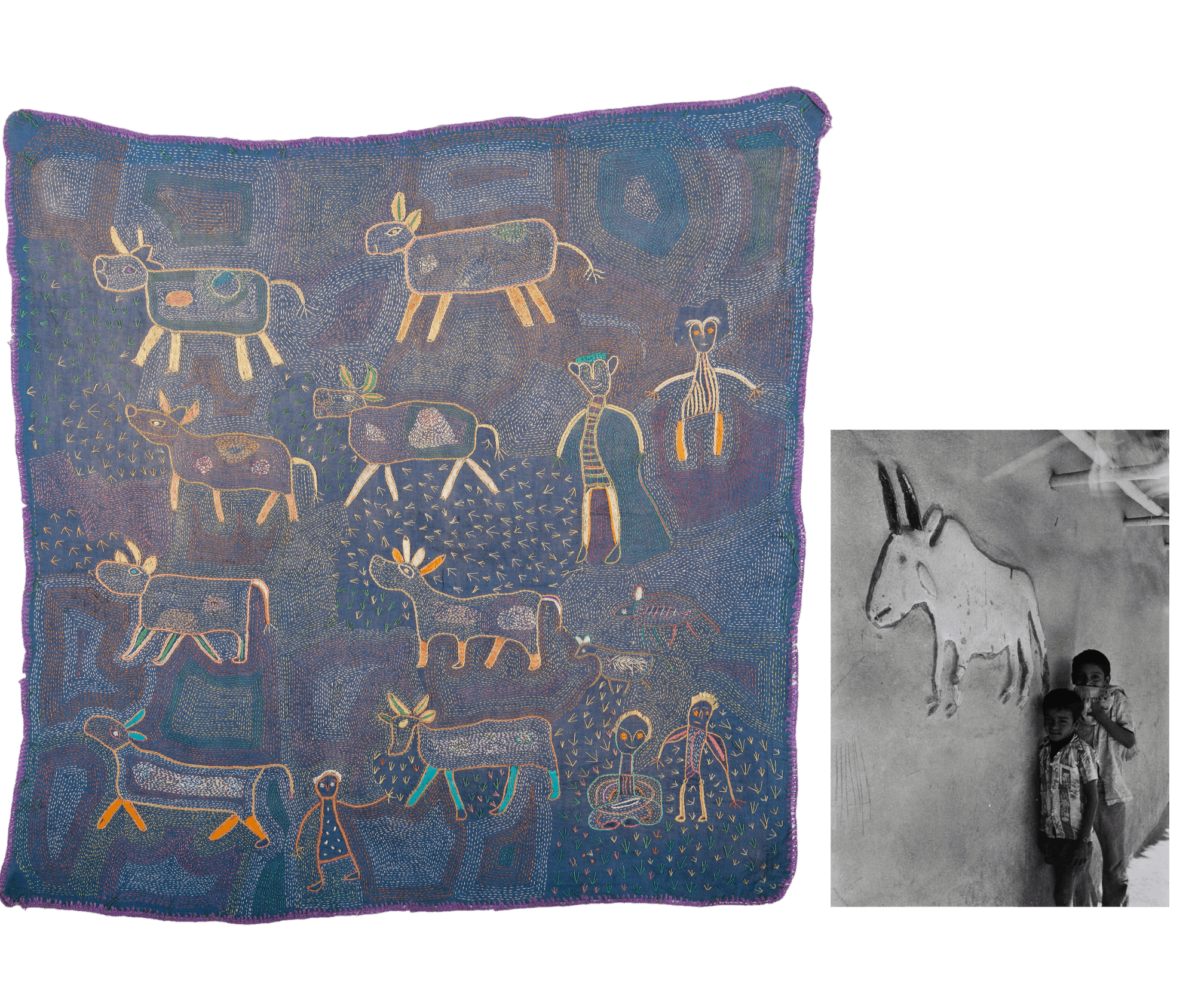
Caption and Script
Caption: A kantha depicting a child or a person with a bull which was made in the 1980s under the guidance of Meera Mukherjee. Next to it is a photograph titled ‘exterior wall of a house in a Santhal Village, West Bengal’ which was made in 1981 by Jyoti Bhatt.
Script: While examining MAP’s collection, I was intrigued by the similarities in kantha stitches, motifs and patterns with photographs of Bengal that were captured by photo-journalist Jyoti Bhatt. In this kantha, I noticed how children draw from games they play and animals they are surrounded by, and then embroider them. Here, at the bottom of the kantha, we can see a kid reaching out his hand to a bull which perhaps grazed the fields where his parents work. Similarly, next to it, there is a photograph by Jyoti Bhatt showing two boys standing next to a wall painting of a similar buffalo with two horns.

A kantha depicting a child or a person with a bull which was made in the 1980s under the guidance of Meera Mukherjee. Next to it is a photograph titled ‘exterior wall of a house in a Santhal Village, West Bengal’ which was made in 1981 by Jyoti Bhatt.
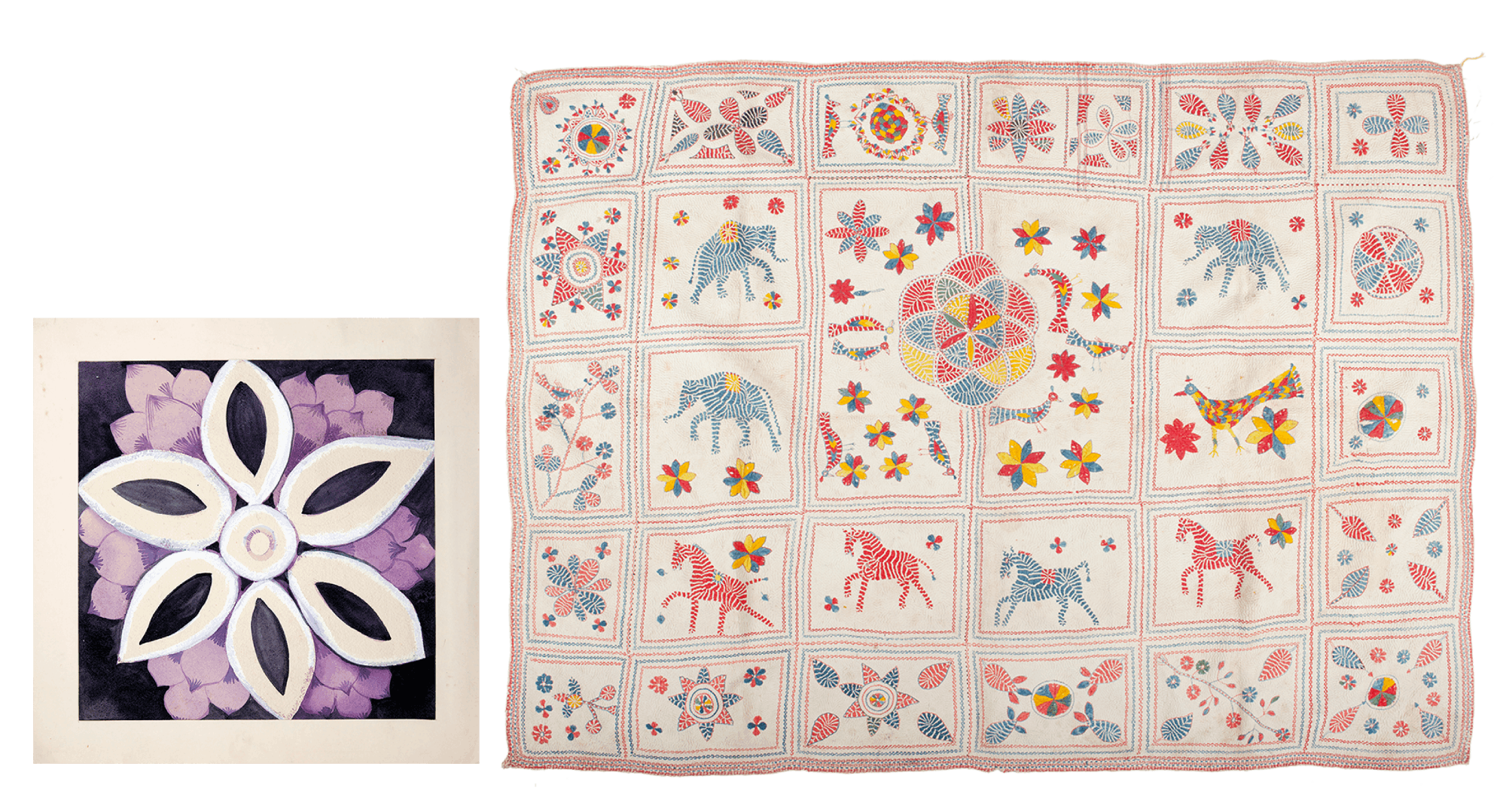
Caption and Script
Caption: A watercolor painting on paper by Meera Mukherjee which was probably made in the late 20th century. Next to it is a kantha depicting segments of various animal and floral motifs which was made in Undivided Bengal in the early 20th century.
Script: In continuation of similarities, I found a watercolor painting of Meera Mukherjee which looks like a simple floral motif but.. if you look closely, the 6 petals in the middle and the smaller petals surrounding it resemble the auspicious symbols in the kantha next to it. Can you imagine the hidden meanings behind these symbols? Can you trace what the other symbols in this kantha mean?

A watercolor painting on paper by Meera Mukherjee which was probably made in the late 20th century. Next to it is a kantha depicting segments of various animal and floral motifs which was made in Undivided Bengal in the early 20th century.
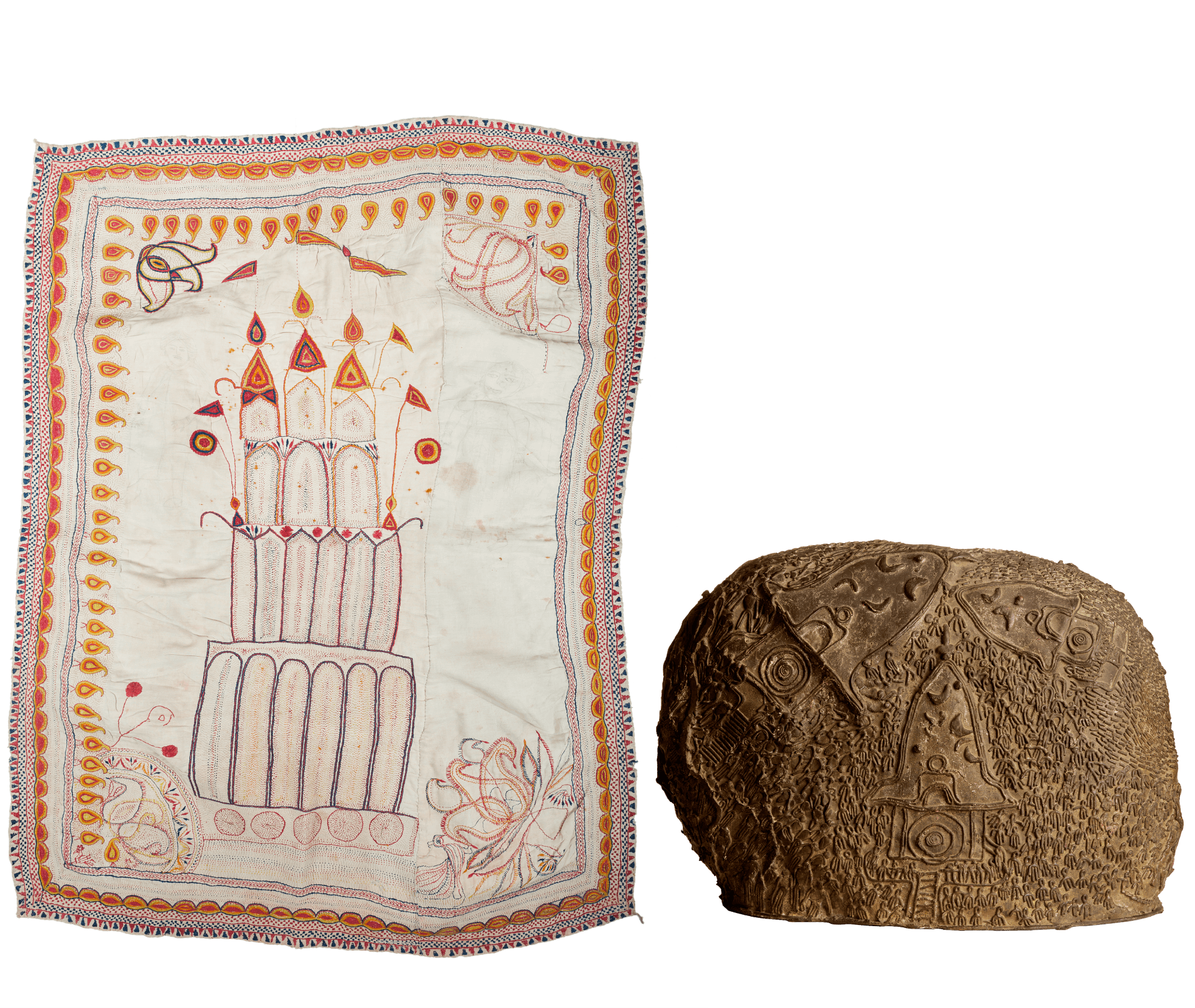
Caption and Script
Caption: A kantha depicting chariot or rath on wheels which was made in Undivided Bengal in the early 20th century. Next to it is a cast bronze sculpture depicting temples in Orissa that devotees visit on their journey known as rath yatra.
Script: The kantha makers not only depicted everyday chores, their staple food or native flowers but also noted their most important spiritual journeys. Like the women who embroider kantha, Meera Mukherjee’s sculptures often signify events that she casts on her bronze sculptures. Among those depicted are fishermen, weavers and women stitching cloth, all forms of labour that are often overlooked and not worthy of being depicted in art works.
When we compare two different mediums like textile and sculpture, I noticed that the kantha depicts a journey on a chariot towards the temples carved on the sculpture. Does this kantha depict a journey to Gundicha ma temples in Orissa? Did the kantha makers and Meera both witness similar events at different points of time?

A kantha depicting chariot or rath on wheels which was made in Undivided Bengal in the early 20th century. Next to it is a cast bronze sculpture depicting temples in Orissa that devotees visit on their journey known as rath yatra.

Caption and Script
Caption: A kantha with a woven border which was made in Undivided Bengal in the 19th century.
Script: The process to weave, use, own, make and mend a kantha takes many life cycles. The keepers of kanthas exchange them, use them regularly or just place them around their homes.
Kanthas are not only a keepsakes of the past. Even today they are being made at home or by artisans to support their livelihoods or in ethical brands to promote sustainability.
The invisibility of the makers and their stories still persist. Have the makers been actively invisibilized? Or is this part of a larger conversation about crafts? Further.. What role does the museum play in all of this?
The black woven border of this kantha tells us about the used saree that it was made from. Women usually embroider the border using threads from the worn out saree but here we see that the maker retains the weave. The touch of used cotton fabric makes the fabric almost flimsy. The sturdy edges disappear in this kantha and remind us that this kantha like the previous kanthas we saw has survived colonialism, partition of Bengal and the pain, hope, faith and joy of its makers.

A kantha with a woven border which was made in Undivided Bengal in the 19th century.
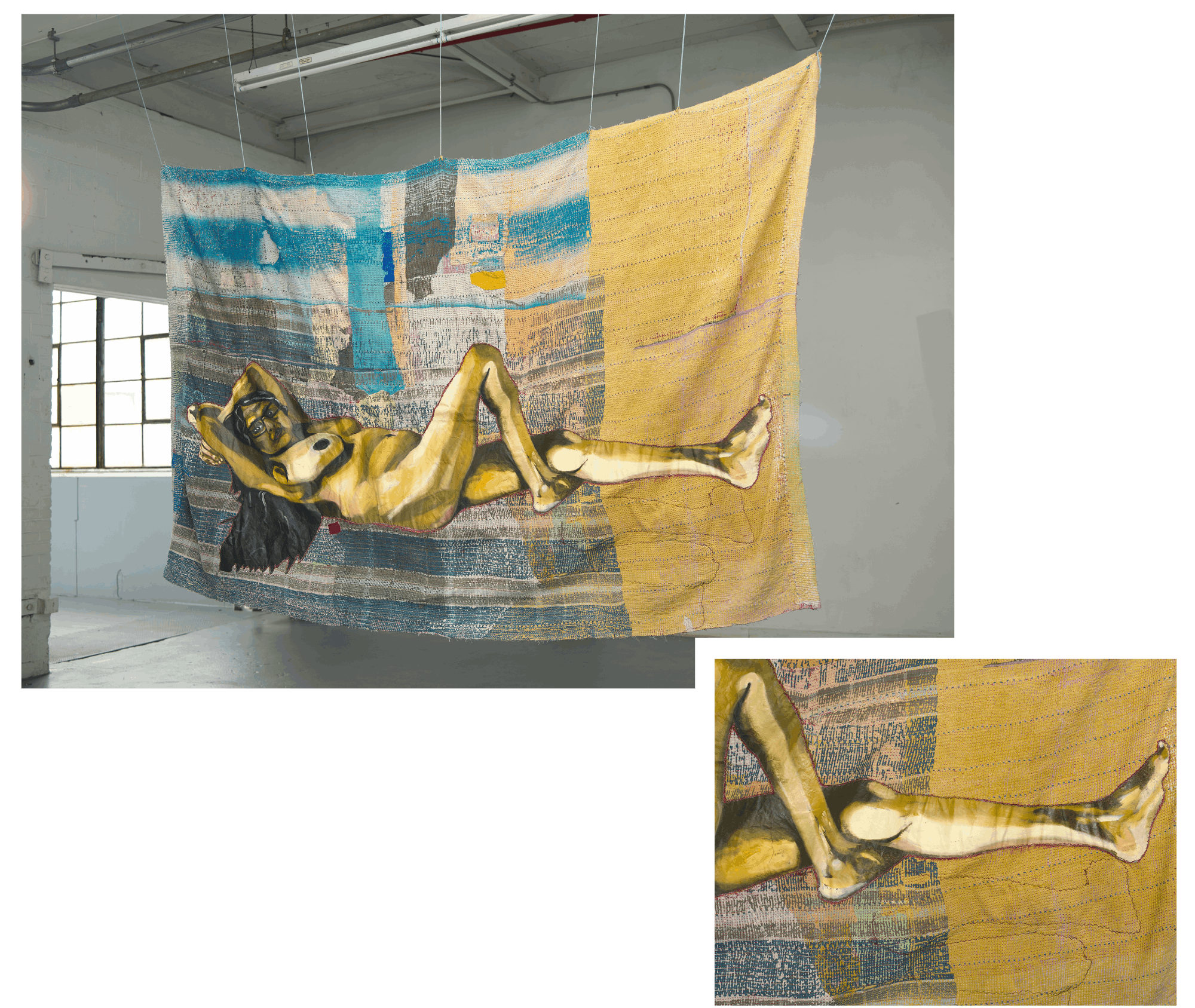
Caption and Script
Caption: One side of the kantha quilt titled करवट (The Turn)made by Bhasha Chakrabarti in 2020 using the medium of oil on used saree, used cloth and thread.
Script: Now..I would like to show you a quilt by a contemporary artist, Bhasha Chakrabarti..who transforms her grandmother’s used sarees into a personal quilt.
When I saw Bhasha’s kantha for the first time I thought this is really what kantha quilts are about. They’re About the women we surround ourselves with, the families we are born into and the care we extend to each other. They’re About making something that lasts, and makes use of what we do not need anymore, but is beautiful in a very personal way. Just looking at the scrap material used here I can see the kinds of garments people wore, sarees, shirts, even denim? I can see the colours people in Bhasha’s family must have liked.
The artwork karvat..in Hindi made by Bhasha Chakrabarti in 2020 imagines and executes the practice of making kantha and yet embodies it with stories woven with every stitch and brush strokes of paint and then sanding it down to uncover the layers of material as well as stitches. The different layers of cloth wear out even further with time, when she uses the quilt to warm herself, as her second skin and to be close to her mom.
She blends stitches with paintings and there is a visibility to her mending / rafugari. Even her photographs of artwork tell a story of kantha making.
Also, The painting of the woman on the kantha is Bhasha’s mother. In some sense, her quilts contain stories of herself, her mother and her grandmother. They shed light on how worn out cloth moved between domestic spaces. Bhasha traces the history of her heirloom quilts and actively participates in keeping it for the future. Although we know who made and mended the karvat quilt, the many artisans who wove Bhasha’s grandma’s sarees remain unknown.
The larger question, for us, is that in this exchange of making, owning and keeping, how do we narrate multiple histories and move away from linear perspectives?

One side of the kantha quilt titled करवट (The Turn) made by Bhasha Chakrabarti in 2020 using the medium of oil on used saree, used cloth and thread.
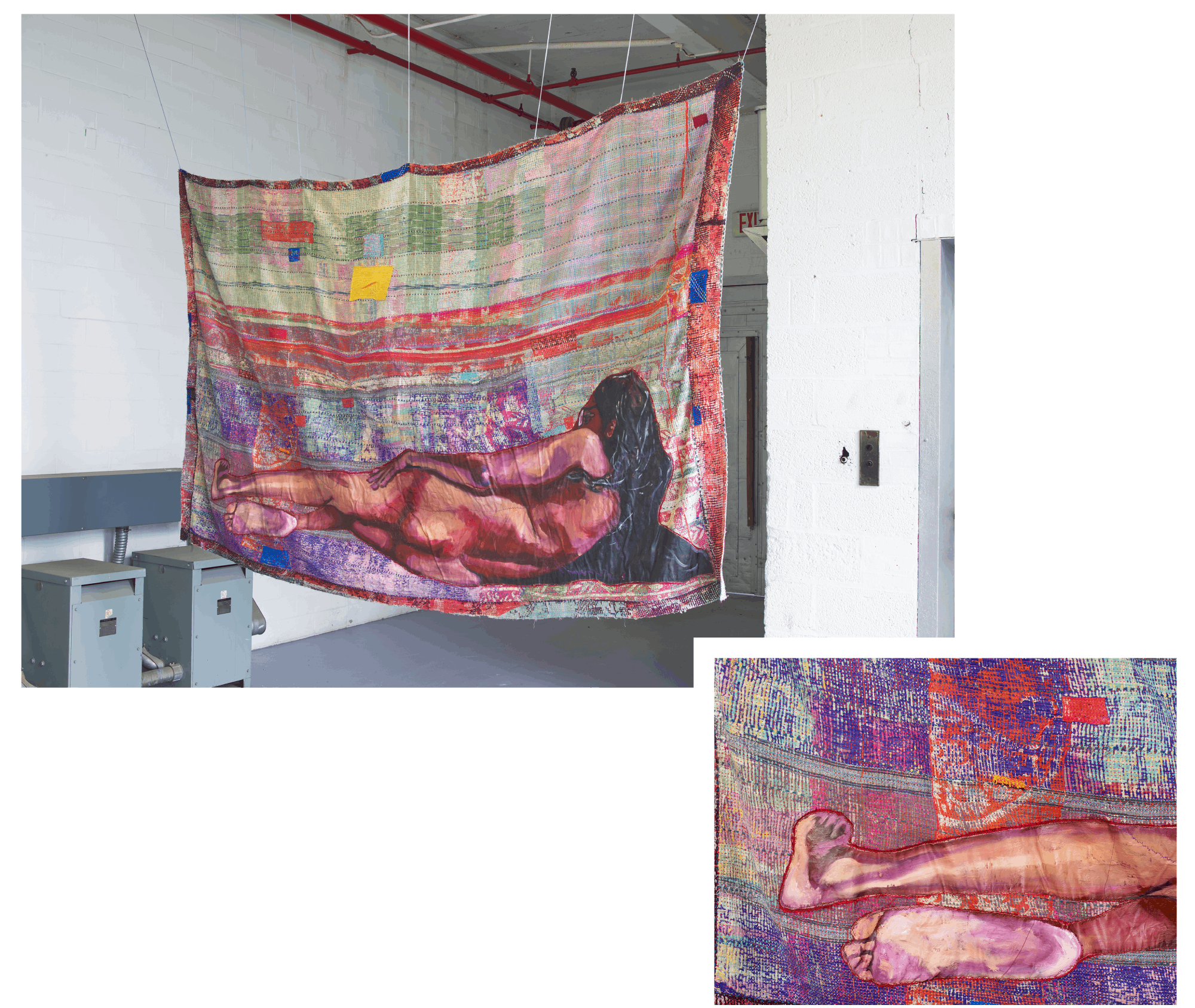
Caption
Caption: The other side of the kantha quilt titled करवट (The Turn)made by Bhasha Chakrabarti in 2020 using the medium of oil on used saree, used cloth and thread.

The other side of the kantha quilt titled करवट (The Turn) made by Bhasha Chakrabarti in 2020 using the medium of oil on used saree, used cloth and thread.
Glossary
Alpana (Bengali)
Ritualistic and transient floor drawings hand painted by Bengali women using a ground paste of rice mixed with water.
Chattayee (Hindi)
Floor mats woven using jute or bamboo fiber. Women often sit on chatayees to embroider quilts in India. The bamboo mats are called bash er chatayees in Bengali.
Kantha (Bengali)
Embroidered quilts patched using worn-out sarees or dhotis, by placing layers of cloth and hand stitching over them. The embroidery thread for decoration is drawn from contrasting borders of the woven cloth. No amount of disuse, tatters, stains and discoloration affected the newly made kanthas.
Kora (Hindi)
Unbleached raw cotton cloth. The thickness of the cloth or number of layers of kora impacted the use of kanthas.
Kalka (Bengali)
A kalka is an auspicious symbol that appears at the corners of the kantha frequently. Typically embroidered as a paisley or a raw mango (ambi), a kalka takes the shape of an unopened bud or seed or tree according to a Bengali woman’s imagination.
Karvat (Hindi)
Turning from one corner to the other. Changing sides.
Motif (English)
Designs, symbols or elements that repeat in a decorative manner. Motifs in kantha signify devotion and spirituality.
Vaishnav kantha (Bengali)
Kanthas with chants of Hindu deities Vishnu, Radha and Krishna, depicted with concentric circles and uniform rectangles. Often made by vaishnava devotees who worship Vishnu and his incarnations.
Bibliography
Ahmad, Perveen. The Aesthetics & Vocabulary of Nakshi Kantha: Bangladesh National Museum Collection. Dhaka, Bangladesh: The Museum, 1997.
Dutta, Adip. “From Child Art to Stitched Painting.” In Meera Mukherjee: Purity of Vision. Ahmedabad: Mapin Publishing, 2019.
Ghosh, Pika. Making Kantha, Making Home: Women at Work in Colonial Bengal. 2020.
Ghoshal, Somak. The Overdue Recognition of Arpita Singh. The Caravan Magazine, 2015. https://caravanmagazine.in/reviews-and-essays/accidental-artist-arpita-singh
Mason, Darielle, Pika Ghosh, Stella Kramrisch, Jill Bonovitz, and Sheldon Bonovitz. Kantha: The Embroidered Quilts of Bengal from the Jill and Sheldon Bonovitz Collection and the Stella Kramrisch Collection of the Philadelphia Museum of Art. Philadelphia, PA: in association with Yale University Press, 2009.
Pal, Pratapditya. Embroidered Dreams: A Personal Appreciation of Bengali Kanthas. Asian art.com, 2018. https://www.asianart.com/articles/kantha/index.html
Sethi, Ritu. Embroidering Futures – Repurposing the Kantha. India Foundation for the Arts, Bengaluru, 2012.http://indiaifa.org/website/publications/kantha/embroidering_futures_repurposing_the_kantha.pdf.
Credits
We are grateful to Bhasha Chakrabarti for allowing us to show her work करवट (The Turn), 2020, Oil on used saree, used clothing, thread 94 x 60 inches. We thank Uthra Rajgopal for her kind advice and support. We thank Paromita Dasgupta, Brishti Modak, Riya Kumar and Vineet Kajrolkar for giving us feedback on the exhibition.
Curators: Vaishnavi Kambadur and Arnika Ahldag, MAP
Inclusion Manager: Kunal Mehta, MAP
ISL Interpreters: Gourav Verma, Indian Sign Language Interpreters Association (ISLIA)
Graphic Design: Abraham John, MAP
Digital Exhibition Development: Kavita Jhunjhunwala, MAP and Sukanta Dutta, Suresh Das, Mass Software Solutions India
Collections: Madhura Wairkar, Clifford Jeffrey, Shreya Chitre, Rucha Vibhute, Prachi Gupta, Patricia Trinidade, MAP
Communications: Priscilla Roxburgh, Krittika Kumari and Shubhasree Purkayastha, MAP
Programming: Shilpa Vijayakrishnan and Shruti Rao, MAP
Animation: Annette Jacob
Bengali translation: Samuel Wright